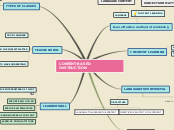EMPIRICISM
Experience is the primary source of knowledge. Organisms are born with basically no knowledge and anything learned is gained through interactions and associations with the environment
Active learner
Reactive learner
knowledge derives from reason without the aid of the senses. humans learn by recalling or “discovering”
what already exists in the mind
RATIONALISM
LEARNING APPROACHES
CONSTRUCTIVISM
learning with creating meaning
from experience, reference tool to the real world. Humans create meaning as opposed to acquiring it. Rather they build personal interpretations of the world based on individual experiences and interactions. Knowledge emerges in contexts within which it is relevant
to instruct the student on how to
construct meaning, as well as how to eff ectively monitor, evaluate, and
update those constructions
Not only have the learners been involved
in diff erent types of learning as they moved from being novices to “budding
experts,” but the nature of the learning process has changed as well.
to align and design experiences for
the learner so that authentic, relevant contexts can be experienced.
elaborate on and interpret information. flexible use of preexisting knowledge rather than the recall of prepackaged schemas. Memory is not
a context-independent process.
Knowledge is not abstract but is linked to
the context under study and to the experiences that the participants bring to the context. As such, learners are encouraged to construct their own understandings and then to validate, through social negotiation, these Although the emphasis on performance and instruction has proven eff ective in teaching basic skills in relatively structured knowledge domains, much of what needs to be learnedb involves advanced
knowledge in illstructured domains.
Assessment focused on transfer of knowledge and skills [presenting
new problems and situations that diff er from the conditions of the
initial instruction].
Supporting the use of problem solving skills that allow learners to
go “beyond the information given” [developing pattern-recognition
skills, presenting alternative ways of representing problems].
An emphasis on learner control and the capability of the learner to
manipulate information [actively using what is learned].
An emphasis on the identifi cation of the context in which the skills
will be learned and subsequently applied [anchoring learning in
meaningful contexts].
Th e need for information to be presented in a variety of diff erent
ways [revisiting content at diff erent times, in rearranged contexts,
for diff erent purposes, and from diff erent conceptual perspectives].
advanced knowledge
acquisition. provides them with the conceptual
power needed to deal with complex and ill-structured problems.
COGNITIVISM
cognitive orientation (where the emphasis is on promoting mental processing) has created a similar shift from procedures for manipulating the materials to be presented by an instructional system to procedures for
directing student processing and interaction with the instructional design system
a prominent role in the learning
process. Learning results when information is stored in memory in an
organized, meaningful manner. Teachers/designers are responsible for
assisting learners in organizing that information in some optimal way
making knowledge meaningful and helping
learners organize and relate new information to existing knowledge
in memory
arranging
practice with feedback so that the new information is eff ectively and
effi ciently assimilated and/or accommodated within the learners’ cognitive
structure
determining the most eff ective manner
in which to organize and structure new information to tap the learners’
previously acquired knowledge, abilities, and experiences
understanding
that individuals bring various learning experiences
to the learning situation which can impact learning
outcomes
TYPES OF LEARNING
reasoning, problem-solving, information-processing. COMMUNICATE
Learning is accomplished when a proper response is demonstrated following the presentation of a specific environmental stimulus.
BASIC PRINCIPLES
Use of cues, shaping and practice to ensure a strong stimulusresponse
association [simple to complex sequencing of practice,
use of prompts]
emphasis on producing observable and measurable outcomes in
students [behavioral objectives, task analysis, criterion-referenced
assessment
Use of reinforcement to impact performance [tangible rewards,
informative feedback]
Emphasis on mastering early steps before progressing to more
complex levels of performance [sequencing of instructional presentation,
mastery learning
Pre-assessment of students to determine where instruction should
begin [learner analysis
MEMORY
transfer is a result of generalization. Situations involving identical or similar features allow behaviors to transfer across common elements
INSTRUCTIONS
arrange environmental conditions so that students can make the correct responses in the presence of those target stimuli and receive reinforcement for those responses
arrange practice situations in which prompts are paired with the target stimuli thatinitially have no eliciting power but which will be expected to elicit theresponses in the “natural” (performance) setting
determine which cues can elicit the desired responses
stimulus-response associations , including the use of instructional cues, practice, and reinforcement.
BEHAVIORISM









